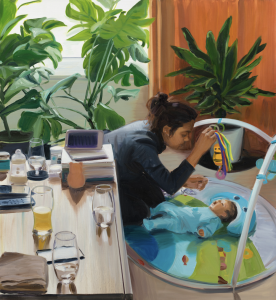Even before the global financial crisis that underwrites every aspect of today’s political and social decision making, the city of Detroit had long been a byword for a kind of uniquely modern post-industrial decay. The Chilean Economist Manfred Max-Neef articulated the concept of the “underdeveloping nation”, a developed nation that consciously undertakes policies which create economic conditions mirroring those of countries much farther down the scale of development. To see contemporary Detroit, as an eloquent, if occasionally overstated, show, titled Ruins of Detroit, by the French photographers Yves Marchand and Romain Meffre demonstrates, is to see Max-Neef’s concept brought into the starkest possible relief.
The decay of Detroit began decades ago as car manufacturers began the process of outsourcing productions to countries with less stringent worker protections; over the last ten years however,global economic cycles have contributed to further corrode even the most basic economic infrastructure of the city.
Marchand and Meffre’s images are striking for the sheer cognitive distance they cover. That such grand buildings as the Lee Plaza Hotel and the United Artists Theatre could ever have existed in a city where, as was the case in 2009, a house—complete with walls, a roof and at least a few fittings—could be had for $1.00 seems almost too bleak to contemplate. There’s something of Anselm Kiefer’s monumentality to the images, and, indeed, no period of history is as instantly evoked by the photographs as Europe in the wake of the Second World War. That such calamity has been essentially self-inflicted should give anyone pondering the current series of economic and ecological crises severe pause. It is necessary, however, to look beyond the political and social implications of the images. While they have an important documentary quality, they also exist as aesthetic objects subject to the protocols and demands of fine art, and are thus more and less than they purport to be.
The aesthetic of lush ruin is intoxicating, but what the images gain in otherworldly beauty they sometimes lose in narrative potency. Happily, frequently there is enough narrative drive within individual pictures to
sustain their visual as well as their social significance, I think particularly of the apocalyptic scatter of the Public Schools Book Depository depicted in an image from 2007. The piles of records and pages, the sheer volume of information strewn about the empty crumbling architecture is staggering, that it exists as a monument to a vanished system of hierarchy and value is at first crushing, but eventually an otherworldly quality of giddy liberation accrues. At times, particularly with the upended piano shown in the Lee Plaza Hotel image and a detail of a melted clock from a classroom at the Cass Technical High School, the poetry of the composition does feel somewhat unnecessarily baroque, even precious, however the unpretentious presentation of the show in the space at Lichtfield Studios pulls the project back from the brink of mawkishness.
If only Detroit had such careful attention applied to it.
The Ruins of Detroit exhibition at London’s Wilmotte Gallery runs from 24th February to 5th April 2012



